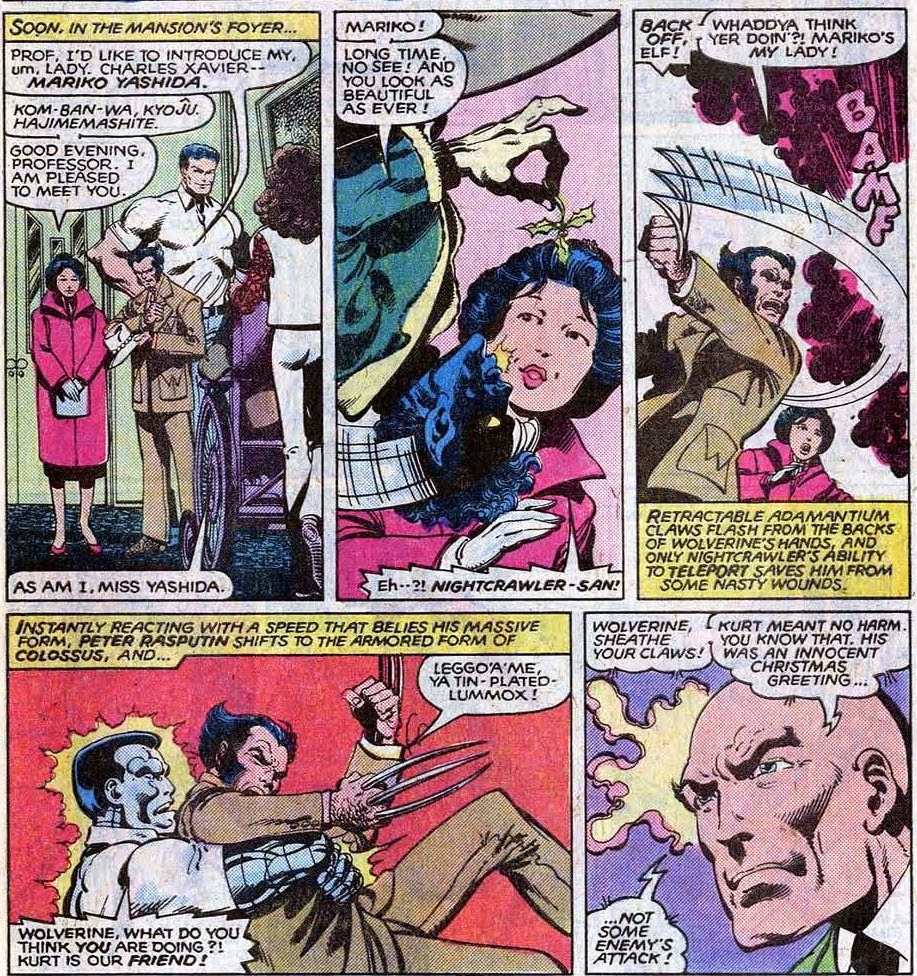Seasons greetings, yon
sequential skinflints, and welcome to the last BARGAIN BASEMENT OF DOOOOOM of
2014. This is a bountiful time of year for the miserly at heart. Achieve
sufficient levels of Scroogitude and you might just be rewarded with a
paranormally fascinating visit from three ghosts of varying temporal
dispositions, as well as one wrapped in chains – and who knows, sexy spectral
times may even ensue if you’re lucky.
Today’s feature is, it’s fair
to say, a blatant cheat. Instead of providing an overview of a title, it seemed
apt to cover a Christmas special. However, most such issues are, frankly,
terrible (JLA #60, anyone? Sensational She-Hulk #8? Yeesh). However, there’s
one glaring exception, which is not only the greatest Christmas issue of all
time, but a classic issue in its own right – namely, Uncanny X-Men #143 (1981).
This was uber-penciller John Byrne’s last issue of his sublime X-run, and as
such goes for a fair few grotes. However, it can also be picked up for next to
nowt in #47 of the reprint series X-Men Classic (formerly Classic X-Men), and
as such, with a little twisting and turning, qualifies for inclusion within the
cheapskate remit of this column.
 |
| Reprint cover by Steve Lightle (1990) |
 |
| Original cover by John Byrne (1981) |
Entitled ‘Demon’, this issue has a pretty simple storyline – not to mention a pretty familiar one. Forty or so issues earlier, the nascent post-Giant Size X-Men team had been plagued by some demonic types (the N’Garai) after Cyclops, wracked with guilt (as is his ongoing wont) had cathartically cut loose with his eyes, his accursed death-dealing eyes, ripped open an ancient cairn and unleashed the forces of hell. As usual, someone else had to clear up Scott’s mess, and Storm eventually managed to seal the gate to the underworld, entombing all the demons. Or so she thought.
 |
| Dave Cockrum, X-Men #96 (1978) |
After a brief flashback to
said events, #143 opens with the Christmas-tree-seeking adventures of Doug and
Ellie Moore, a young, frisky couple keen to embark upon a long and happy life
together, were it not for the leftover hellbeast that brutally extinguishes
their future. Cut to the nearby X-Mansion, where the various team members are
heading out for some Christmas Eve fun. After Wolverine introduces a note of
tension into the evening by genuinely attempting to slice Nightcrawler in two
for an etiquette misstep (the guy had severe anger-management issues in those
days), everyone goes their separate ways, leaving the team’s newest and
youngest member, Kitty Pryde, alone in the mansion. Her solitude is soon
shattered, however, when the abode is invaded by the aforementioned demon,
hell-bent upon feasting upon her entrails. The rest of the issue is essentially
one long cat-and-mouse sequence, with Kitty forced out of the predatory role
her name would imply. As she attempts to evade the creature, it becomes
painfully clear that her mutant phasing power offers little defence, and she
must rely on her wits to get out alive.
Beautifully rendered by Byrne
(along with classic ink-partner Terry Austin), this issue not only borrows
heavily from the recently released Alien, but is an entirely blatant homage –
everything from the design of the creature to its eventual fate is taken almost
directly from Ridley Scott’s film. As if the source material weren’t obvious
enough, Kitty even directly references it – ‘Too bad I don’t have some
king-size flame-throwers handy! They used them to fight the monster in that
movie!’ There are also several instances of classic horror-movie tropes – the
death of the sexually active couple, the severed phone-line, the Carrie
fake-out.
For all its lack of
originality, what’s great about this one-shot story is both its claustrophobic
horror and its showcasing of Kitty’s capabilities and strength of character.
The tension really gets ramped up as her attempts to use the mansion’s tech and
resources to escape the demon prove increasingly futile (not to mention
colossally destructive). ‘Demon’ is basically a Kitty Pryde solo story – she
was only 13 or 14 at this time, had only appeared for the first time a dozen or
so issues earlier, and had largely been behind the scenes since. She did play a
role in Days of Future Past, but as her older self in her younger body (as you
do). This is a great, rounded portrait of the young and inexperienced Kitty.
She’s alone. Her power is unflashy and defensive. And she’s no warrior,
grimacing confidently in the face of impossible odds. Naturally, she’s
terrified – but, crucially, not scared witless… she beats the beast with
brains, not brawn.
Clearly a favourite of
Claremont’s, Kitty would go on to become a pivotal and much-beloved
X-character, but #143 remains arguably her finest hour. All good Kittiness –
from the Kitty Pryde and Wolverine mini through Excalibur to her Emma
Frost-entombing exploits in Astonishing X-Men and beyond – stems from this.
That’s all for now… I hope you
enjoyed this humble gift. May your Christmas be full of cheer, and relatively
free from unstoppable 12-foot Giger-esque diabolical hellfiends intent upon
ripping your flesh asunder and devouring your very soul.






















